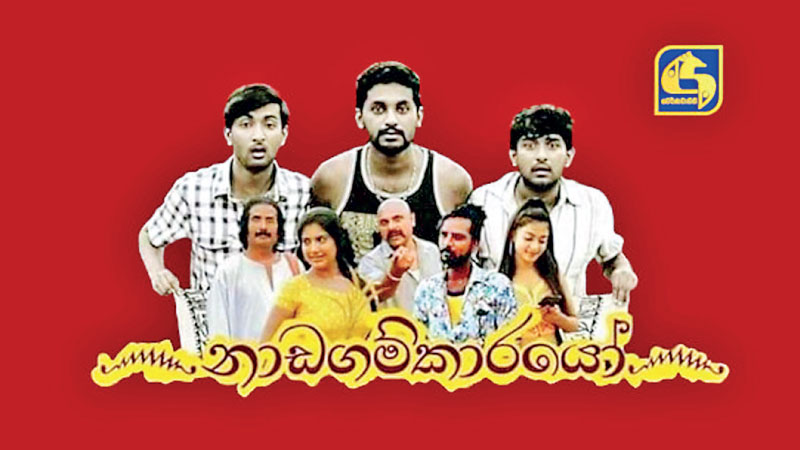Friday Jan 16, 2026
Friday Jan 16, 2026
Monday, 15 August 2022 00:07 - - {{hitsCtrl.values.hits}}

 Despite the doom and gloom all around, there are good things to talk about and ‘Nadagamkarayo’ (Drama Folks), the most popular Sinhala teledrama of recent times is one such. Whilst we see key people display many dramas to hoodwink general masses, the people whom we met in ‘Nadagamkarayo’ added value with meaningful ‘edutainment’. Today’s column is a management perspective of this award winning tele drama.
Despite the doom and gloom all around, there are good things to talk about and ‘Nadagamkarayo’ (Drama Folks), the most popular Sinhala teledrama of recent times is one such. Whilst we see key people display many dramas to hoodwink general masses, the people whom we met in ‘Nadagamkarayo’ added value with meaningful ‘edutainment’. Today’s column is a management perspective of this award winning tele drama.
Overview
Nadagamkarayo was telecasted on Swarnavahini channel from 18 January 2021 to 2 August 2022 completing 400 episodes. It is categorised in the genre of romantic comedy drama thriller. With a brilliant script by Saddha Mangala Sooriyabandara, it was directed by Jayaprakash Shivagurunathan, an accomplished award winner. From the first episode itself, it had over one million viewers in YouTube and is acclaimed as the most trending Sinhala teledrama so far.
With the involvement of talented artists such as Sajitha Anuththara, Prasannajith Abeysuriya, Giriraj Kaushalya, Senali Fonseka, Kokila Pawan Jayasooriya, Rahal Bulathsinhala and Sangeeth Prabhu, the drama created memorable and vibrant characters.
Story unfolded
The overarching story involved a rural setting with a scenic village, Karandutenna. The socio-economic facets in a religio-cultural fabric are realistically portrayed with the inclusion of an admired Buddhist monk (Loku Harmuduruwo), an authentic music teacher (Master), a multi-talented youngster (Sara) and many other impactful characters. The incessant struggle to survive amidst multiple challenges with both positives and negatives of human behaviour is impactfully included.
The constructive forces represented by the Buddhist monk and the Master (music teacher), and the destructive forces represented by the Liqour Seller (Kukula Mudalali), and rural politician (Pradeshiya Manthree) are on an ongoing clash. The bitter (perhaps a bit abrupt) ending was due to the corrupt involvement of a powerful minister who is also the leader of the district where this village belongs to.
The drama portrayed the continuing significance of the Eastern music whilst showcasing the positives and negatives of a typical village life. The way the unleashing the rural talent was done by the Master aptly guided by the Loku Hamuduruwo was memorably shown throughout the drama.
As a sub theme, the continuing dialog with technology and tradition was also explored in this teledrama. It contained a character called Malan de Silva who represented urban values with an imposed posh approach in regularly visiting Karandutenna village in his car. He criticised the oriental music promoted by the Master and commented on its inability to make an international impact through social media. In contrast, he advocated a modern Western music and dancing approach which was not very much appealing to the villagers. At the end, he was exposed as one originating from a nearby village with humble parents who were genuine enough in sharing his real identity.
Alienated youth in focus
A story supposed to be from “rags to riches” has an abrupt ending. Yet, the highlighting of the plights of alienated rural youth is vividly done by the creators. Sara (the gang leader) who started as an illicit liquor maker together with his friends, Kavadiya, Kiri Putha and Sudda. Having caught by Police, they attempt to escape on the way to the Police Station and the transformation begins in that run for a hideout. Two remarkable guides help them to convert. One is the Master, an Eastern music teacher who conducted a regular class free of charge for the village youth. The other is the Loku Hamuduruwo, the head priest of the Temple. The romance between Sara and Patalie, the elder daughter of Master added glamour to the glittering episodes.
The questionable support by the so-called government officials towards the SMEs is realistically portrayed here. Among many inefficient and insensitive state officials, there was one Business Development Officer who went out of the way to help the four youngsters in going for a business registration, obtaining a bank loan, and purchasing of machinery and equipment. Ironically, she is harassed by another jealous colleague who accused her of doing more to get a promotion.
To cut a long story short, the four youth who were dealing with illicit liquor as a livelihood, end up being entrepreneurs in supplying coconut husk chips for export market. That adventurous journey of them with rejecting, struggling, exerting, and persevering takes them to an admirable position.
Management insights through a SWOT analysis
In the process of guiding the four youngsters, the Loku Hamuduruwo gives each one of them an exercise book and a pen asking them to do an assessment of strengths, weaknesses, opportunities, and threats regarding them. The script writer has skilfully articulated the value of a comprehensive SWOT analysis which could be the basis of progressive growth. Though the four youngsters in focus were branded as “kassipu karayos” (illicit liquor dealers), their hidden potential in drama, arts and entrepreneurship started to blossom, thanks to the timely guidance.
It was interesting to note that the social media presented the SWOT before the drama characters actually did so. I still recall one of my MBA “learning partners” from Oman had done so and shared it in LinkedIn. I observed the wide viewership, truly fitting to the trending claim that the drama was showcasing, and also the enthusiasm of the viewers to engage in analysing the characters seriously.
The way a start-up business involving the collection of coconut husks evolved to the making of coconut husk chips using a machine for export marker was a story of courage and commitment, offering a ray of hope for entrepreneurial job seekers.
The story apart from its artistic theme of Nadagama, pays tribute to the wonders of coconut. The script writer has acknowledged the support he obtained by a few government officials who played an active silent role in promoting coconut related businesses among the rural youth of Sri Lanka. In fact, coconut being one of Sri Lanka’s three major export crops, the versatility it offers in brining dollars to Sri Lanka is immense. Since ancient times, Sri Lankans got the best use of coconut not wasting a single part of it.
Role of an ideal religious leader
I have heard people playing tributes to the Loku Hamuduruwo in this teledrama who personifies an ideal Buddhist Monk. In stark contrast to some popular characters, we often see in the media, this great leader works more as a servant in upholding not only the spiritual wellbeing of the villagers but also their socio-economic needs to some extent. Using the donations to the temple to provide medicines to poor villagers is one such example.
Obviously, such forthright servant-leaders face opposition from extremists from many fronts, including the very own lay leaders (Dayakayas) of the temple. Lekam Mahattaya (secretary of the Dayaka Sabha) who works against the Head Priest in the guise of upholding “Sinhala Buddhism” represents many popular characters patronised by some media channels.
The script writer has acknowledged the guidance given to him by many scholarly Buddhist monks in creating this “ideal religious leader” who made a lasting impact in the minds of the viewers. It was an insightful and inspirational demonstration of “spiritual intelligence” where genuinely connecting with the burning issues faced by the villagers was the key.
The final few episodes resonated a potential conflict between regional political leadership and the village temple. Whilst the opportunistic Lekam Mahattaya (honorary secretary) of the Dayaka Sabaha (temple council) wanted the district leader to have his political meeting in the Bana Maduwa (temple hall), the Head Monk showed his displeasure and was very much against it, simply ignoring the possible political favours in return. The prolonged issue resulted in Loku Hamuduruwo leaving the temple allowing the so-called wish of the influential few to be implemented by force. They had the audacity to say with confidence, “we will bring a monk to our temple who will support our expectations.” The destruction of unblemished values of innocent villagers by the opportunistic politics was impactfully portrayed towards the dramatic end.
Vibrancy of a new generation
The young characters portrayed in this drama highlighted the vibrancy of a new generation that is multi-talented with a fine blend of arts and crafts. The challenge is to match the strengths with opportunities. For Sara and other friends, it had always been a bumpy ride with stumbling blocks becoming stepping stones. The mindset of dreaming big and stretching oneself for lofty achievements was something alien to them, until proper guidance and mentoring by a few genuine supporters was provided.
Despite their coconut husk plant being destroyed by the fire set by the thugs of the powerful regional politician, their dream of a coconut products factory was further ignited. The drama ends with a positive tone with vibrant youth aspiring to reach greater heights. It reminds me of what Dr. Abdul Kalam said. “Dreams are not what you see when you are asleep; they are what make to stay awake and to work.”
Way forward
“Nadagamkarayo” (Drama Folks) was acclaimed as the most socially impacted (“Janagatha”) teledrama at the most recent Raigam Tele Awards. What the director, the script writer and all the talented artists involved have collectively done is to create multi-faceted edutainment with arts and crafts in focus, featuring the prospects and pitfalls of rural progress. I look forward to seeing the second season of it, with more managerial insights of entrepreneurial success.
(The writer is the immediate past Director of the Postgraduate Institute of Management, and can be reached through [email protected], [email protected] or www.ajanthadharmasiri.info.)